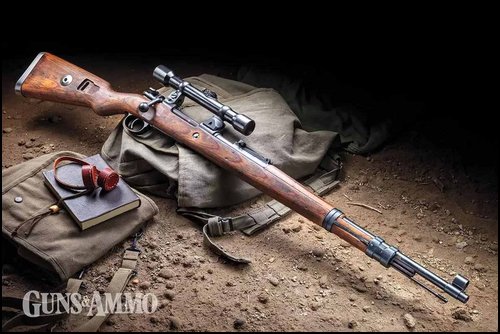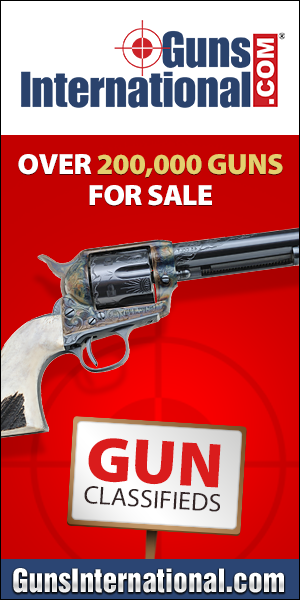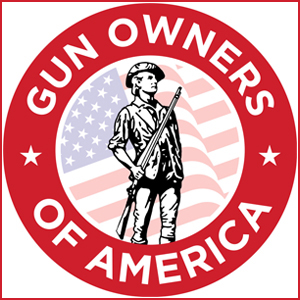The German’s attitude towards sniping was much like the American’s and British prior to World War II, largely ignoring the role. During World War I, the Germans employed scoped Gewehr 98 (G98) rifles effectively in the trenches of France. However, prior to World War II, the Wehrmacht abandoned sniping. In July 1935, a month after the Karabiner 98 kurz (K98k) was adopted and production started, the Wehrmacht put out a directive ordering all scoped rifles in storage to be set aside because they would not be used anymore. The telescopic sights were to be removed and sold. In February of 1938, the Wehrmacht began selling off its telescopic sights to military officers, senior sergeants and civilian officials. However, pre-war intelligence of the Russians caught up to them, and all previous orders for liquidating the Wehrmacht’s telescopic sights were halted within one month.
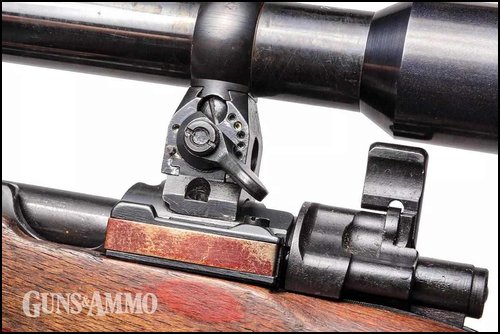 |
| The Zf.39 turret mount was stout, involving both screws and soldering to the receiver. The rear mount featured a quick-release lever to either lock the scope in place or remove it. A Carl Zeiss Zielvier 4X was sourced for testing. (Photo by Mark Fingar) |
The SS began producing sniper rifles in 1939. The rifles were assembled with short-side rail mounts that were built primarily on World War I-vintage G98 rifles reworked to K98 specifications. The short side rail mount was attached to the bolt-lug raceway on the left side of the receiver. This setup was found to be inadequate in the field as it invariably worked its way loose with repeated firings.
Several different models of commercially available telescopic sights were then procured, predominantly with 4X magnification, but a few 6X scopes have been identified. The most common of these scopes was the Zeilfernrohr (Zf.) 39, which was made in several forms by manufacturers including Ajak, Hensoldt, Kahles, Zeiss, and others.
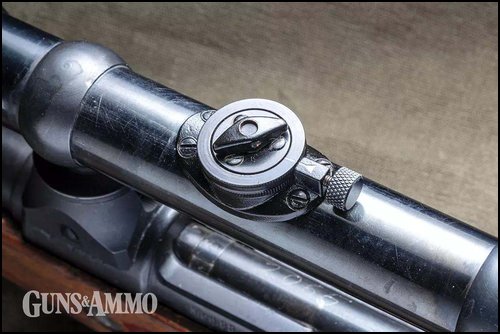 |
| The Zf.39 featured a knurled ring for adjusting elevation with a bar in the middle to adjust focus. (Photo by Mark Fingar) |
The reticle featured a vertical post with a sharpened point and horizontal posts extending from the side, but not intersecting with the vertical post. The scopes had an elevation turret with a knurled ring for elevation adjustment and a small bar in the center of the turret allowed for focus, but there was no windage adjustment in the scope. Later in the war, a long side-rail mount was used on rifles with an uncut, thicker bolt raceway. This arrangement proved to be more robust.
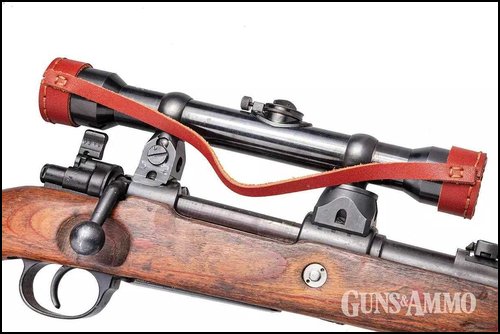 |
| Snipers were issued a metal can to store the Zf.39 for transportation. A leather scope cover protected the lenses in the field. (Photo by Mark Fingar) |
At about the same time the SS was building sniper rifles, the Wehrmacht started a program for the ordnance department to assemble its own K98k sniper rifles with the low turret mount. It was a much stronger and more robust system than the side rail mount. It consisted of large bases on the front receiver ring and rear receiver bridge that were both screwed and soldered to the receiver. The scope was soldered into the rings. The scope and rings were turned into the front base and rotated 90 degrees into a dovetail in the rear mount and locked in place with a small lever. The rear mounting ring allowed windage adjustment with two opposing screws. The ordnance department’s requirements for rifles to convert to snipers noted they had to have a “perfect bore,” whatever that meant. Accuracy testing was not done for rifle selection.
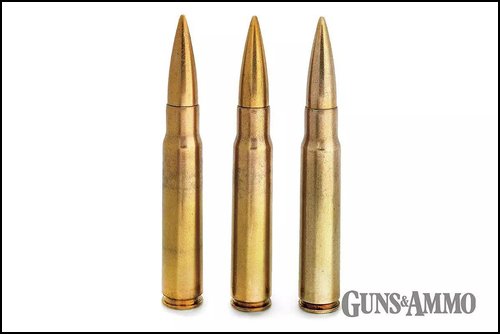 |
| S8x57 test ammunition (left-to-right), 1939 SmK; 1938 s.S. Patrone; 1940 s.S. Patrone. (Photo by Mark Fingar) |
Formal Production
After the invasion of Poland on September 1, 1939, the Wehrmacht awarded contracts to rifle manufacturers to build K98 sniper rifles. This provided far greater production and improved the performance of the system as the manufacturers selected the best-shooting rifles during production testing for conversion to a sniper rifle. Early in the Russia campaign, a number of the World War I-era G98 scoped rifles, aforementioned, were reassembled and issued as the Wehrmacht fell increasingly victim to Russian snipers. It was common practice, well into 1943, for the Germans to use captured 91/30 sniper rifles against the Russians. German sniper Josef “Sepp” Alleberger — 257 confirmed kills — used a captured 91/30 PU rifle for nearly a year, successfully, before attending sniper school and being issued a K98k with Zf.39 scope in late-summer 1944.
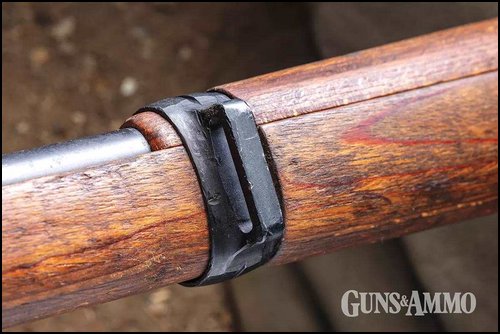 |
| The K98k Zf.39 carried the same rifle features as the standard-issue K98k, including the front sling-attachment point. (Photo by Mark Fingar) |
Throughout the war, attempts were made to improve the performance of the K98k sniper rifles. Different types of scopes and mounts were experimented with, and the turret-mount scoped rifles became the most produced sniper. The Germans also fielded large numbers of the Zf.41 K98k after 1941, equipped with essentially a long-eye-relief scope mounted above the rear sight. It was a small aperture, dim and small-field-of-view 1.5X magnification scope that was considered worthless and ineffective by troops. They also fielded large numbers of the semiautomatic Gewehr 43 (G43) rifle with the Zf-4 4X magnification scope. The G43 was not as accurate as the K98k, but it was valued for its firepower and rapid follow-up shots.
As far as expectations of the German sniper, I could find little information on this. However, both Alleberger and sniper Bruno Sutkus stated that the majority of their engagements were from 150 to 400 meters. Alleberger added that there was much talk of kills at 800 meters, but he said this was a lot of bluster. The real snipers considered any attempts at those distances a circus shot.
 |
| No special treatment was given to the triggers of the K98k Zf.39. Sniper rifles were selected for demonstrated accuracy. (Photo by Mark Fingar) |
My test Zf.39 K98k was a Russian-capture, “AR 41”-coded Mauser Borsigwalde K98k with a nearly new bore. I acquired steel low-mount turrets and a Carl Zeiss Zielvier Zf.39 reproduction scope, which was made in Jena, Germany, to the same specifications as the original Zf.39. The only other work I did to the rifle was to adjust the bedding to produce 4 to 5 pounds of upward pressure on the barrel from the front of the forend. I also made sure that — other than the front 3 inches of the stock forend — the rest of the stock barrel channel did not contact the barrel. I felt that these modifications were appropriate due to the rifle being a Russian capture with a number of mismatched parts. (Original rifles were assembled and fitted this way, too.) The trigger was clean with no creep but tested at a heavy 6 pounds, 11 ounces. The rifle weighed heavy at 10.9 pounds.
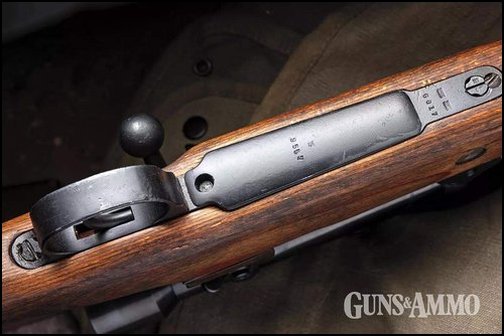 |
| Unlike some veterans’ numbers-matching bring-back K98s, Russian capture examples often feature mismatched parts. (Photo by Mark Fingar) |
8x57mm Mauser Ammunition
At the start of World War II, the standard-issue load for the German army was the s.S. Patrone with a 198-grain spitzer boattail bullet. The load was intended for long-range machine-gun fire. In 1940, the semi-armor-piercing S.m.E. load was introduced. Lead was in short supply in Germany, so the core was changed to a mild steel with a thin lead shell around it. The S.m.E. bullet weighed 178 grains, and the S.m.E. loads replaced the s.S. Patrone by 1942. The series also included a tracer round called the S.m.E. “L’Spur,” for “Leuchtspur.” In 1943, the lead content was reduced further, but the length of the mild steel core was increased to offset the loss of lead in the core. The new load was called the S.m.E. “lang” for “long.” This load had a near-identical trajectory as the s.S. Patrone to 1,531 yards (1,400 meters). The s.S. Patrone and S.m.E. series were the mainstay of the German infantry in World War II. The S.m.K. AP load was produced throughout the war, and it featured a hardened steel core with a weight of 183 grains. The S.m.K. L’Spur was an AP-T tracer load with a hardened steel core, having a projectile weight of 157 grains. The s.S. Patrone and S.m.K. loads were sought after by snipers because they were known to be accurate. The s.S. “Anschuss” load was a special purpose, tight tolerance load that was used for accuracy testing of production rifles and in repair centers. This was probably the most accurate load available and was highly sought after by snipers, but it was not readily available. Due to material shortages, cartridge cases were converted from brass to lacquered steel in the 1940 to ’41 timeframe. By 1942, virtually all 8x57 ammunition was steel case. Incidentally, the S.m.K. load barely defeats 5/16-inch of armor at 500 yards. (I had a piece of armor at the test range and couldn’t help myself.)
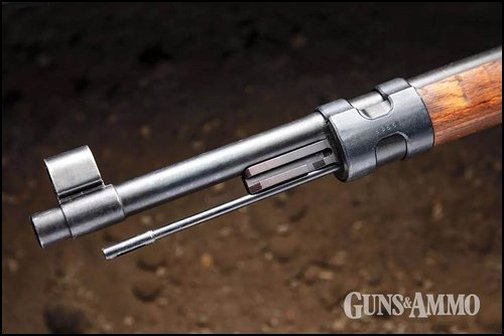 |
| Stamped steel barrel bands and milled H-style barrel bands appeared on K98k Zf.39 sniper rifles. (Photo by Mark Fingar) |
In the memoir “Sniper on the Eastern Front” (2008), Alleberger reported shooting s.S Anschuss ammunition at sniper school but never said it was available in his unit on the Eastern Front. In his memoir “Sniper Ace” (2009), Sutkus reported he hoarded any pre-war ammunition he could find, including captured Yugoslavian ammo. He stated these were both more accurate. In February of 1945, Hitler approved the use of the B-Patrone spotter (explosive) load for use on the Eastern Front. It was a last-ditch effort to exact heavier casualties on the Russians to try and slow their advance. For testing the Zf.39 K98k, I found some pre-war 1939 s.S. Patrone ammunition and 1939 S.m.K. loads. I also found a small amount of early war s.S. Patrone ammunition from 1940.
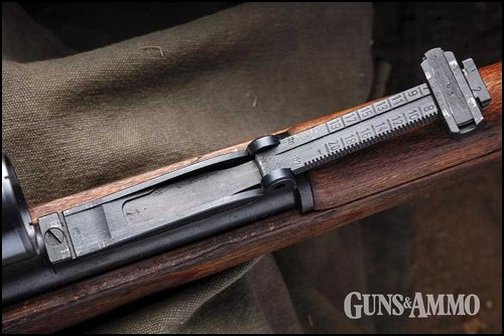 |
| The K98k Zf.39 retained the tangent-curve, 100- to 2,000-meter, adjustable rear leaf sight in case the scope was damaged. The turrets had a tunnel to allow for use of the standard sights. (Photo by Mark Fingar) |
At the Range
Testing was done on a known-distance (KD) range with targets at 100, 200, 300, 400 and 500 yards. We fired at the B27 human silhouette target to more closely match the sight picture that would have existed for a sniper. We only fired three-shot groups at each range to conserve our limited ammunition supply, and we zeroed the Zf.39 K98k with a handload of 43.6 grains of IMR 4064 and Nosler’s 200-grain boattail hollowpoint (BTHP) with several five-shot groups.
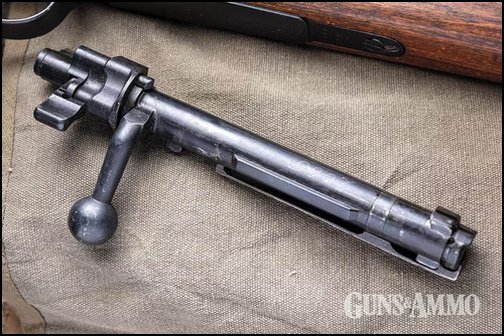 |
| Neither the blued bolt or safety assemblies were altered on the K98k Zf.39. Some late-war rifles had a lower safety to improve its ease of use. (Photo by Mark Fingar) |
The Zf.39 scope has the worst elevation mechanism of war’s sniper rifles. It is simply a course-threaded lead screw with a small tab on the reticle that engages the thread. It offered questionable repeatability and lots of backlash. It may have been a decent hunting scope, but it was not a precision riflescope. If adjustments were made in the same direction, the scope tracked reasonably well. Getting a precise adjustment was difficult. If you need to adjust it in the opposite direction, you have to go way beyond the target setting and then come back to it. Another problem with the scope is that elevation will change significantly when the turret-locking screw is tightened. Precise adjustments were nearly impossible. Sutkus reported that he was instructed in sniper school to get an accurate 300-meter zero and then not to touch the scope again. “Know your trajectory and compensate.” I would totally agree with this for the Zf.39 scope. To zero the rifle in windage, the opposing screws in the rear scope ring must be adjusted. It was difficult to get a precise adjustment for testing. There was no consideration for adjusting windage to individual shots in the field. Hold-offs are the only practical way to adjust for windage.
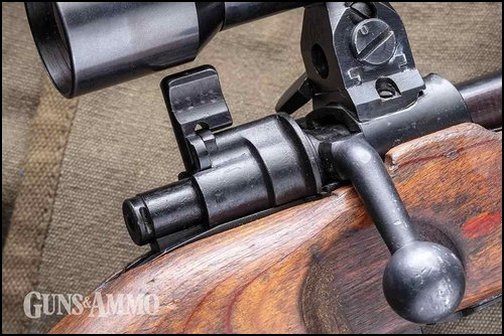 |
| The handle of the Model 98a carbine was turned down, and the stock was relieved for clearance to grasp it. There was minimal risk of interference with the Zf.39 scope when lifting the bolt. (Photo by Mark Fingar |
After zeroing at 100 yards, the test team moved to 300 yards and zeroed with the handloaded ammunition. We then touched up the zero with the s.S. Patrone load, and fired at all ranges using the predicted trajectory of each period load. This effort proved acceptable for holding the torso of the target to 500 yards. Winds during the test were 10 to 20 miles per hour (mph), fishtailing from 12 o’clock to 2 o’clock. We avoided shooting against gusts, and Guns & Ammo Editor-in-Chief Eric Poole was the trigger man on the bench while I spotted for wind. Despite the issues with the Zf.39 scope, the K98k was accurate with all three loads. I would fully expect later war ammunition performance to progressively degrade, which was noted by Sutkus. (Results to be published in Part 4 for comparison.)
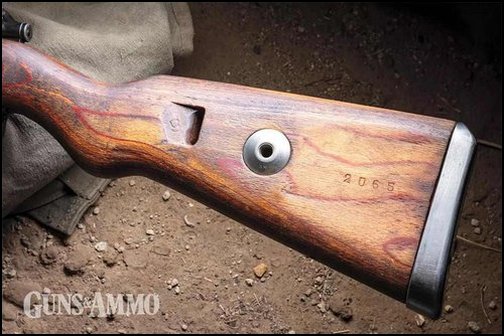 |
| Guns & Ammo’s test rifle was Russian-capture, evidenced by the markings on the stock and the stamped serial number. (Photo by Mark Fingar) |
Our standard practice was to try and shoot in the same wind condition based on wind flags and observing vegetation, but it was too windy to read mirage. We succeeded most of the time, but several of the groups showed an obvious miss of calling a wind condition. With the low, fixed-power scope and thick post reticle, wind corrections were generally “Hold right-half, hold right-edge of the silhouette,” or “Hold right-edge of cardboard.” Greater resolution wasn’t possible, especially beyond 300 yards. In nearly every group, the elevation size of the group was less than — or much less than — the windage group size.
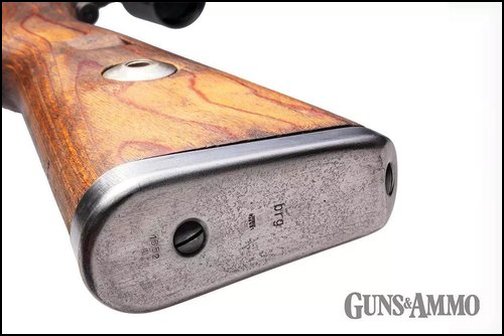 |
| The “brg”-mark indicates the buttplate with waffenampt was made by H. W. Schmidt in Döbeln, Germany. (Photo by Mark Fingar) |
The Zf.39 K98k, though accurate, was a difficult rifle to use because of the scope issues. It would have required a well-trained sniper to use it effectively in war. As is the case with most any K98k and period ammunition, recoil was substantial. Shooting one of these in a protracted engagement would have left one bruised. The high-mounted scope and no cheekrest makes getting a consistent head position difficult, but a trained and practiced sniper would have been effective to 500 yards. Effectiveness would have decreased rapidly beyond 500 yards due to the low-power scope, thick post reticle and having to use holds instead of dialing.
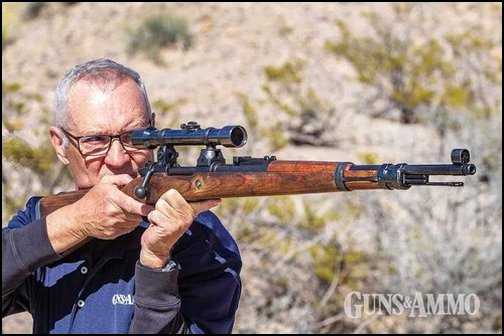 |
| Recoil from the 8x57mm-chambered K98k was significant. Lacking adjustment, the scope required estimated holds for hits. (Photo by Mark Fingar) |
Mauser Model 98K Zf.39
- Type: Bolt action
- Cartridge: 8x57mm Mauser
- Capacity: 5 rds.
- Barrel: 23.62 in., 1:9.45-in. twist rate
- Length: 43.6 in.
- Weight: 10 lbs., 14 oz. (tested)
- Stock: Beech wood, laminate
- Finish: Blued (steel), phosphate (steel)
- Sights: A-post (front); V-notch, tangent curve leaf, elevation adjustment, 100m to 2,000m (rear); Zf.39 4X scope
- Trigger: 6 lbs., 11 oz. (tested)
- Safety: Three-position lever
- Manufacturer: Mauser Werke, Germany
Coming next month: In Part II, we examine the .303-caliber, Lee-Enfield No. 4 Mk I (T) sniper rifle with No. 32 scope.
Related Categories
Article courtesy of
Guns & Ammo.
